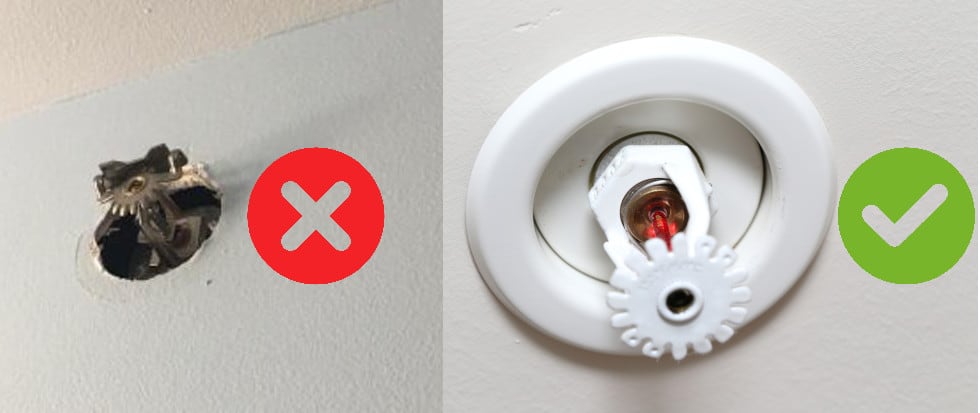NFPA 25 mandates replacing missing fire sprinkler escutcheons that are part of listed assemblies. Here’s why this equipment matters.
Escutcheons surround many fire sprinklers, filling in the distance between the heads and the holes cut to expose them. These devices provide a clean, attractive installation for pendent and sidewall sprinklers in finished walls and ceilings—and you’ll notice missing fire sprinkler escutcheons because they reveal unsightly gaps.
But beyond aesthetics, many escutcheons are also “listed” to perform as part of a “sprinkler assembly.” And NFPA 25: Standard for the Inspection, Testing, and Maintenance of Water-Based Fire Protection Systems requires replacing these listed parts if they go missing.
Clearly, there’s more going on with escutcheons than just looks. So, let’s examine why listed escutcheons matter (or might matter) for performance, including:
- Understanding “listings” and the “sprinkler assembly”
- How the wrong escutcheons may impact water distribution characteristics of flush and recessed sprinklers
- Do missing fire sprinkler escutcheons impact sprinkler activation times?
- Do you need to replace all missing fire sprinkler escutcheons?
Understanding “listings” and the “sprinkler assembly”
NFPA 13: Standard for the Installation of Sprinkler Systems requires using listed escutcheons for pendent or sidewall sprinklers that utilize them and are installed “flush” with the wall or ceiling or “recessed” into it:
From the 2022 edition of NFPA 13
7.2.6.2* Escutcheons used with recessed, flush-type, or concealed sprinklers shall be part of a listed sprinkler assembly.
Note that the term “escutcheon” regarding concealed sprinklers essentially refers to a part of the “sprinkler cup” surrounding a head that sits entirely within the ceiling or wall behind a cover plate. It differs from the distinct metal rings surrounding non-concealed sprinklers, which are the focus of this blog.
Why do “listings” and “sprinkler assemblies” matter?
Major manufacturers make escutcheons compatible with specific sprinklers, testing how everything performs as a complete unit: a “sprinkler assembly.” Assemblies that meet specific performance requirements are “listed” by safety organizations such as UL and FM Global.
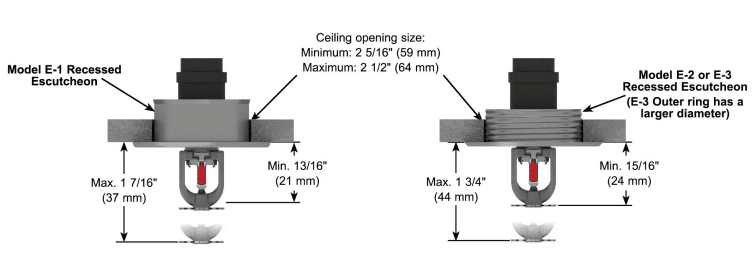
This concept explains why NFPA 25 mandates replacing absent listed escutcheons with listed models—or the entire sprinkler and its assembly if listed escutcheons aren’t available:
From the 2023 edition of NFPA 25
5.2.1.1.5 Escutcheons and coverplates for recessed, flush, and concealed sprinklers shall be replaced with their listed escutcheon or coverplate if found missing during the inspection.
5.2.1.1.5.1 Where the listed escutcheon or coverplate from a listed assembly is missing and is no longer commercially available, the sprinkler shall be replaced.
But NFPA 25 does not require replacing missing non-listed escutcheons for sprinklers “that are not recessed, flush, or concealed,” which it also refers to as “standard escutcheons” or “beauty rings.” Another way to describe those other types of sprinkler installations is “surface-mounted;” the heads don’t sit back into the wall or ceiling; they’re almost completely exposed.
So, why NFPA requirements for one escutcheon type and not the other?
It goes back to the sprinkler assembly and listing concepts:
Many recessed, flush, and concealed sprinklers are listed as part of an assembly with their escutcheons or coverplates. When these pieces are missing, the sprinkler may not perform as designed and must be replaced.
Section 3.3.215.2* of NFPA 13 outlines the “sprinkler characteristics” that result in the desired performance of a sprinkler:
- “Thermal sensitivity. A measure of the rapidity with which the thermal element operates as installed in a specific sprinkler or sprinkler assembly.”
- “Temperature rating.” [The activation temperature of the sprinkler’s thermal element.]
- “K-factor.” [The size of the orifice where water comes out, impacting flow and coverage.]
- “Installation orientation.” [Pendent, sidewall, or upright sprinklers.]
- “Water distribution characteristics (i.e., application rate, wall wetting).” [The size and direction of spray.]
- Special service conditions. [Characteristics that adapt to specific needs to reach a performance objective, like corrosion-resistant sprinklers, dry sprinklers, and other types.]
Missing or improper escutcheons that aren’t part of a listed sprinkler assembly have the potential to impact two of the above factors: water distribution characteristics and thermal sensitivity.
Here’s a look at each and whether the possible effects are significant.
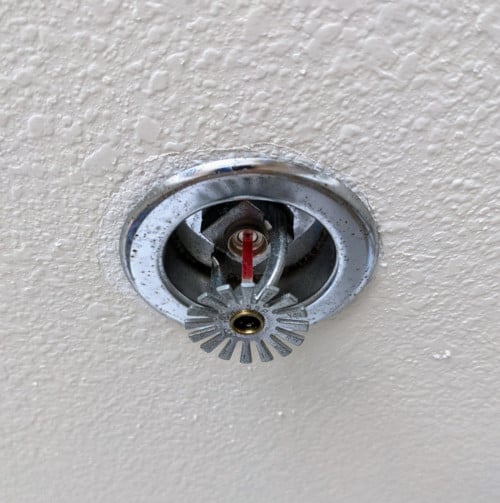
Why the wrong escutcheons may impact spray patterns
NFPA 13 requires either metal or listed escutcheons around all sprinklers that have them while specifically demanding listed models for recessed or flush sprinklers:
16.2.5.1 Plates, escutcheons, or other devices used to cover the annular space around a sprinkler shall be metallic or shall be listed for use around a sprinkler.
16.2.5.2* Recessed and flush sprinklers shall be installed with the escutcheon that is part of its listing.
NFPA 13 explains that the metal is necessary because escutcheons made of other materials “can deform or melt” during a fire “and impair the operation or discharge characteristics of the sprinkler.” And the alternative listing requirement is because any non-metallic escutcheon that is listed would mean the manufacturer has tested the escutcheon material’s fire resistance.
Listed escutcheons are only specifically required for recessed and flush sprinklers—not surface-mounted heads—because both of those installations mean the sprinkler head sits back into the wall or ceiling a bit. “Flush” may imply that the sprinkler is even with the plane of the ceiling or wall, but it really still has some recession into it.
So, listed escutcheons are needed for flush and recessed sprinklers because they’re tested as part of the sprinkler assembly and help ensure proper placement of and clearance for the sprinkler. NFPA 25 lays out this rationale:
A.16.2.5.2 The use of the wrong type of escutcheon with recessed or flush-type sprinklers can result in severe disruption of the spray pattern, which can destroy the effectiveness of the sprinkler.
Instances have occurred in which the dimensions of a recessed escutcheon that was not investigated or listed with a sprinkler were such that the deflector was not clear of the escutcheon, which seriously impaired the spray pattern. Failure to follow all manufacturer’s instructions and listing criteria can result in less than acceptable performance of the sprinkler.
In addition, missing escutcheons might indicate a problem with sprinkler placement, as pointed out by an NFPA 25 committee member during the standard’s 2013 annual revision cycle (emphasis added):
[T]he outer ring of a recessed sprinkler head and the cover plate assembly of a concealed sprinkler head are of a specific dimension to insure [sic] that the sprinkler deflector is at the proper distance below the ceiling. The missing trim may be due to the ceiling sagging thus affecting the spray distribution of the sprinkler.
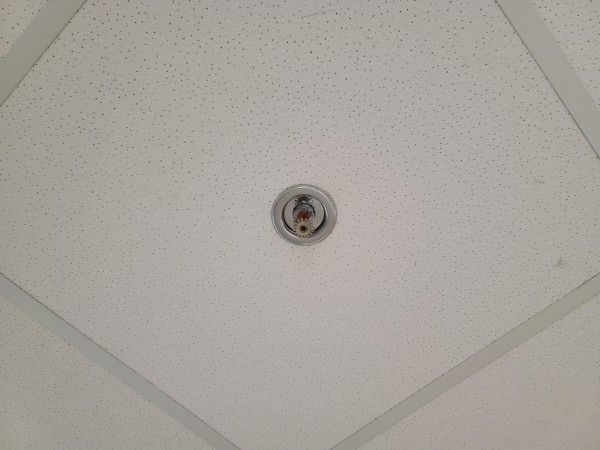
Do missing fire sprinkler escutcheons impact sprinkler activation times?
The idea that missing escutcheons can delay sprinkler activation has been conventional wisdom in the fire protection industry. QRFS has stated this possibility, as have many fire protection contractors. There’s even speculation that missing escutcheons could delay a nearby smoke alarm’s activation.
The rationale is that when hot gases from a fire rise, they can escape into the annular space left open by a missing escutcheon, diverting into the wall or ceiling around a fire sprinkler’s temperature-sensitive element. This results in delayed heat accumulation around the sprinkler and could delay it from going off.
Here are some of the possible mechanisms relating to a sprinkler’s response time index (RTI), as described in NFPA 13’s explanation of sprinkler characteristics (emphasis added for relevant aspects):
The RTI of a sprinkler is a function of the convective heat transfer coefficient, the specific heat of the operating element, the mass of the operating element, and the surface area of the operating element. Other factors that can affect a sprinkler’s thermal sensitivity in the field include temperature rating, position from the ceiling, attachment to piping, and anticipated fire exposure.
Elsewhere, NFPA 13 elaborates on things that can affect response:
Many […] factors, such as ceiling height, spacing, ambient room temperature, and distance below ceiling, affect the time of response of sprinklers.
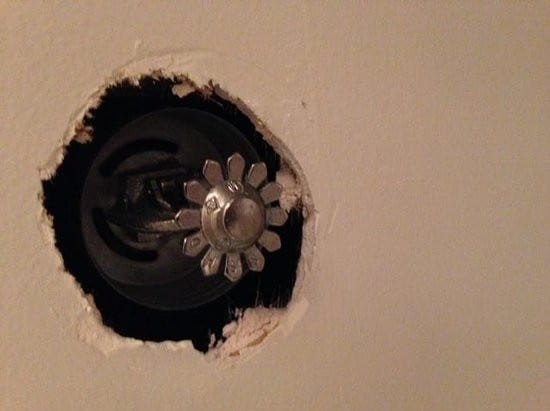
Some editions of NFPA standards have explicitly warned readers about the possibility of delayed activation, such as this reference from the 2016 edition of the Automatic Sprinkler Systems for Residential Occupancies Handbook (NFPA 13D/R Handbook; emphasis added):
For recessed escutcheons (regardless of material), the sprinkler must be listed with the escutcheon in place to determine how the flow of hot gases will affect the operating time of the sprinkler. Once listed, the escutcheon becomes a part of the sprinkler assembly and the sprinkler must be installed as it was listed, with the specific escutcheon. [7.5.8]
However, recent NFPA 25 and 13 editions make no mention of the potential for missing escutcheons to impact a sprinkler’s response. And the 2014 edition of the NFPA 25 Handbook explicitly says it’s a “negligible” issue (emphasis added):
Exhibit 5.20 shows a sprinkler with an incomplete escutcheon assembly. While some of the hot gases from a fire might escape into the plenum, the impact on activation time is negligible, which is why this is commonly referred to as a noncritical deficiency.
Again and interestingly, later editions make no mention of delayed activation—neither whether it’s relevant or “negligible.”
For example, the 2017 NFPA 25 Handbook only says that missing escutcheons that are part of a listed assembly must be replaced because a sprinkler “may not perform as designed.” (5.2.1.1.6) Whether that design impediment strictly means spray patterns or also activation times is left unsaid.
Possibly adding to any confusion is that non-listed escutcheon-sprinkler combos don’t need replacement escutcheons. And, of course, exposed sprinklers not installed with escutcheons in the first place seem to activate fine, even when they hang directly from pipes surrounded by air. It all implies that the impact of hot gases escaping into a ceiling or wall around a missing escutcheon might not be a big deal.
However, remember that manufacturers test the performance of sprinklers with compatible escutcheons as a “sprinkler assembly.” And during the 2013 annual revision cycle for NFPA standards, one manufacturer’s representative cited the possibility of a delayed-activation effect.
Tyco Senior Applications Specialist Gordon Farrell provided the following “substantiation” for the change submission to require replacing missing listed escutcheons with listed escutcheons (emphasis added):
The use of the wrong type of escutcheon with recessed or flush sprinklers or the wrong cover plate can result in the severe disruption of the spray pattern as well as affect the thermal sensitivity of the sprinkler.
So, what’s the bottom line? Can missing escutcheons delay the activation times of a fire sprinkler in a listed assembly or not?
Here’s our take: maybe, but it’s not an emergency situation that will “impair” the sprinkler or system. An otherwise functional fire sprinkler should still go off very close to its rated activation temperature and according to its thermal sensitivity. But there is at least some chance of a slight delay since manufacturers test sprinkler performance as a complete assembly.
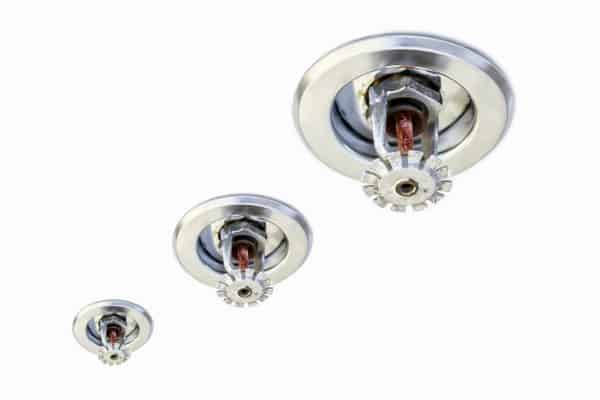
Do you need to replace all missing fire sprinkler escutcheons?
Technically, “no” for unlisted models. “Yes” for those that are part of a listed sprinkler assembly.
NFPA 25 regards absent listed escutcheons as a “noncritical deficiency,” the least urgent problem on the spectrum of fire protection system deficiencies and impairments.
But noncritical deficiencies still require “appropriate corrective action” (11.1.5.3). And it’s better to be safe than sorry regarding anything that could affect the spray pattern or even possibly slightly delay sprinkler activation, given that seconds count during a fire.
You’ve got to replace listed escutcheons regardless. And besides: pendent and sidewall sprinklers within finished walls that don’t have listed or non-listed escutcheons look terrible.
If you need to buy replacement escutcheons, QRFS has you covered. Check out our selection, including listed escutcheons from Tyco, Senju, Viking, Victaulic, and Reliable.
You can also read our other blog to learn how to find replacement escutcheons compatible with your sprinklers.
If you have any questions about finding a compatible escutcheon or need help ordering an item, contact us at 888-361-6662 or support@qrfs.com.
This blog was originally posted at blog.QRFS.com. If this article helped you, check us out at Facebook.com/QuickResponseFireSupply or on Twitter @QuickResponseFS.


